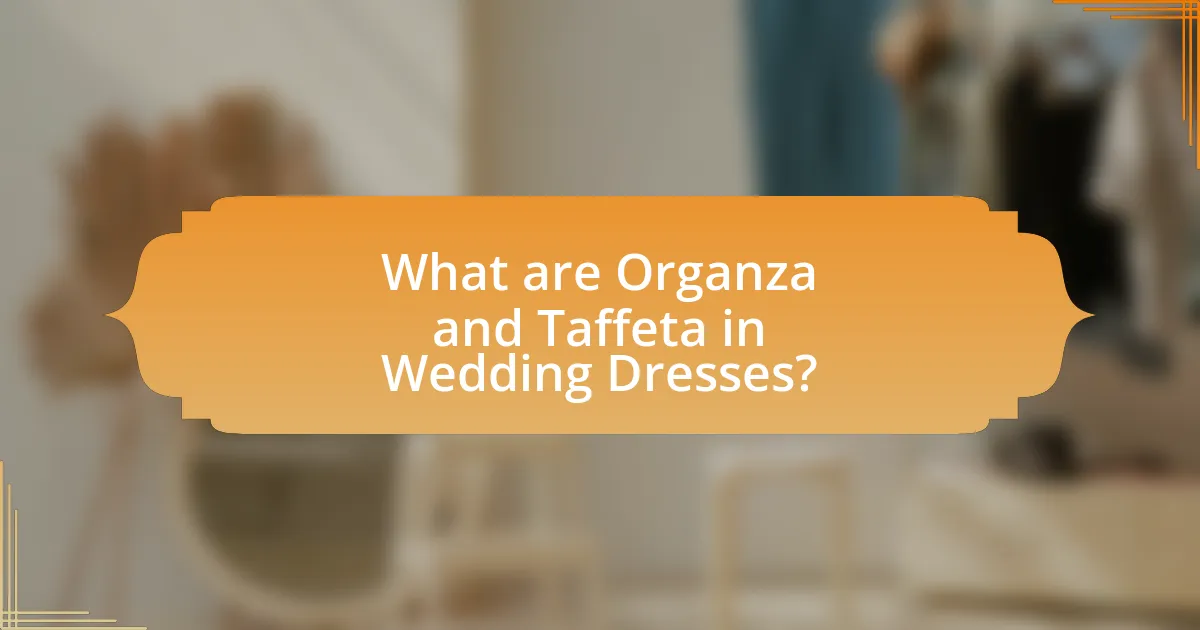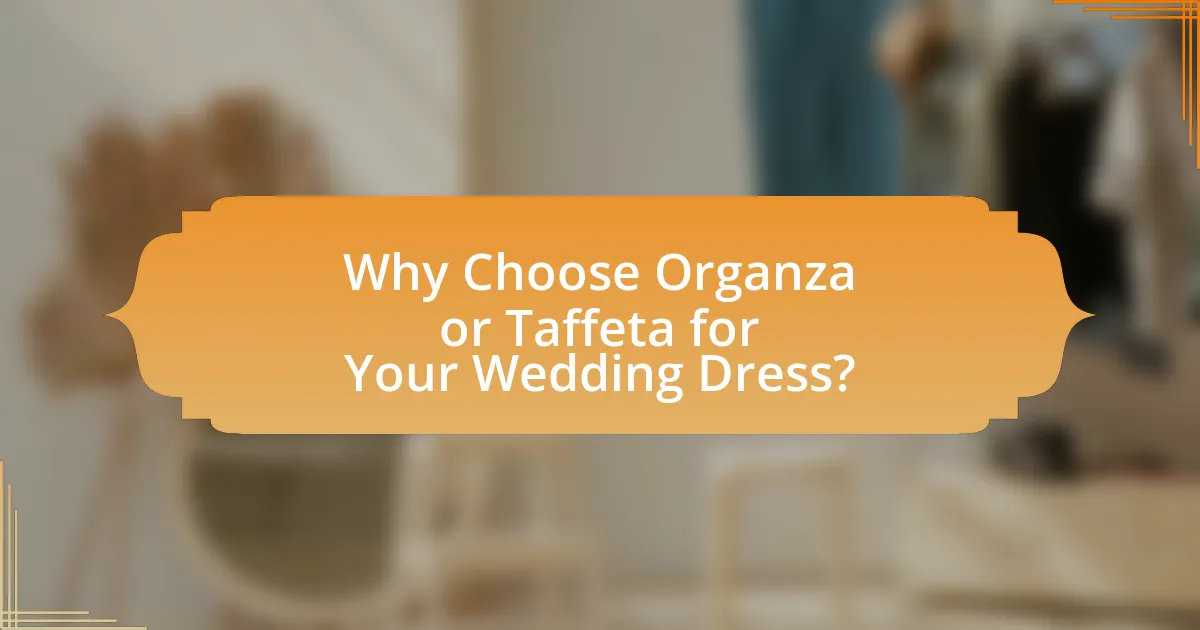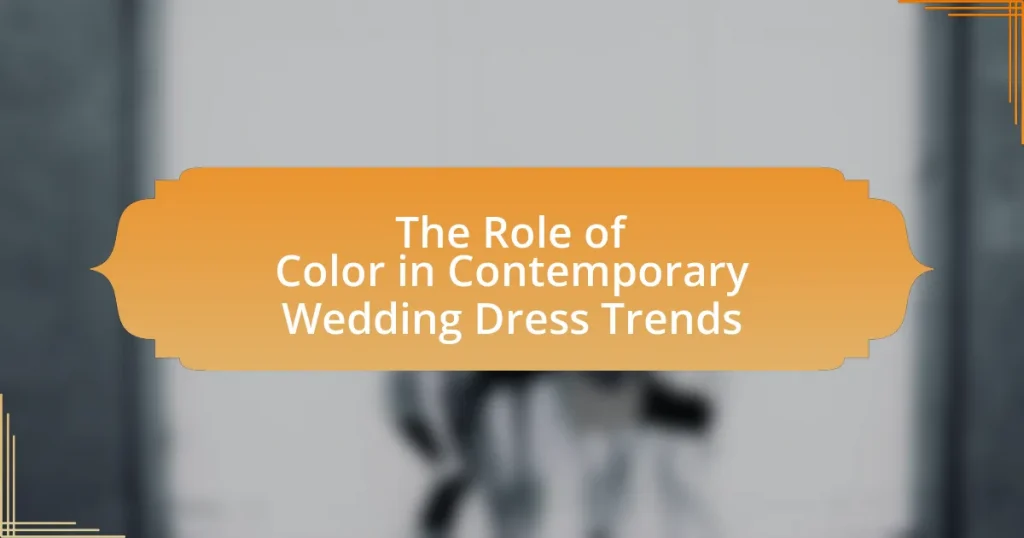Organza and taffeta are two lightweight fabrics frequently used in wedding dresses, each offering distinct characteristics that influence design and aesthetic. Organza is a sheer, crisp fabric ideal for overlays and voluminous skirts, while taffeta is slightly heavier with a smooth finish, providing a structured and elegant silhouette. The article explores the differences in texture, sheen, draping qualities, and common uses of these fabrics, as well as factors influencing their selection, such as climate and comfort. Additionally, it outlines maintenance requirements and best practices for cleaning and storing dresses made from organza and taffeta, ensuring longevity and preservation of their unique qualities.

What are Organza and Taffeta in Wedding Dresses?
Organza and taffeta are both lightweight fabrics commonly used in wedding dresses. Organza is a thin, sheer fabric made from silk or nylon, known for its crisp texture and ability to hold shapes, making it ideal for overlays and voluminous skirts. Taffeta, on the other hand, is a slightly heavier fabric with a smooth finish, often made from silk or polyester, recognized for its lustrous sheen and structured drape, which provides a more formal appearance. Both fabrics contribute distinct aesthetic qualities to wedding gowns, with organza offering a delicate, ethereal look and taffeta providing a sophisticated, elegant silhouette.
How do Organza and Taffeta differ in texture?
Organza has a crisp, lightweight, and sheer texture, while taffeta is characterized by a smooth, slightly lustrous, and more structured feel. The crispness of organza allows it to hold shapes well, making it ideal for creating volume in wedding dresses, whereas taffeta’s smoothness provides a more elegant drape and a subtle sheen, contributing to a sophisticated appearance. These distinct textures influence how each fabric behaves in design and construction, with organza often used for overlays and taffeta for linings or structured elements.
What are the unique characteristics of Organza?
Organza is a lightweight, sheer fabric known for its crisp texture and ability to hold shapes. This fabric is typically made from silk or polyester, which contributes to its delicate appearance and slight stiffness. Organza’s unique characteristics include its transparency, which allows for layering in designs, and its subtle sheen that adds elegance to garments. Additionally, organza is often used in wedding dresses for its ability to create volume and structure without adding significant weight, making it a popular choice for overlays and embellishments.
What are the unique characteristics of Taffeta?
Taffeta is a crisp, smooth fabric known for its lustrous finish and structured drape. This fabric is typically made from silk or polyester, which contributes to its lightweight yet durable nature. Taffeta’s unique characteristics include a slight sheen that enhances its visual appeal, making it a popular choice for formal wear and wedding dresses. Additionally, taffeta holds its shape well, allowing for voluminous silhouettes and structured designs, which is particularly advantageous in bridal fashion. The fabric’s ability to resist wrinkles and its crisp texture further solidify its status as a favored material in the creation of elegant garments.
What are the visual differences between Organza and Taffeta?
Organza and Taffeta are both lightweight fabrics, but they exhibit distinct visual differences. Organza is characterized by its sheer, translucent quality, which gives it a delicate and airy appearance, often used for layering in wedding dresses. In contrast, Taffeta has a crisp, smooth texture with a slight sheen, providing a more structured and formal look. The differences in opacity and texture between these two fabrics make Organza suitable for soft, flowing designs, while Taffeta is ideal for creating defined shapes and silhouettes in bridal attire.
How does the sheen of Organza compare to Taffeta?
The sheen of Organza is generally more subtle and delicate compared to the more pronounced and lustrous sheen of Taffeta. Organza, made from silk or nylon, has a crisp texture that reflects light softly, creating a gentle glow. In contrast, Taffeta, often made from silk or polyester, has a smoother surface that produces a high-shine finish, making it appear more vibrant and reflective. This difference in sheen is significant in the context of wedding dresses, where the choice between the two fabrics can affect the overall aesthetic and visual impact of the gown.
What draping qualities do Organza and Taffeta exhibit?
Organza exhibits a lightweight, crisp drape that creates a structured silhouette, while Taffeta has a slightly heavier, more luxurious drape that provides a smooth, flowing appearance. The crispness of Organza allows it to hold shapes well, making it ideal for creating volume in wedding dresses, whereas Taffeta’s smooth texture enhances the elegance of flowing lines and soft movement. These distinct draping qualities are essential in wedding dress design, influencing the overall aesthetic and fit.
What are the common uses of Organza and Taffeta in wedding dresses?
Organza and Taffeta are commonly used in wedding dresses for their unique textures and structural qualities. Organza, a lightweight and sheer fabric, is often utilized for overlays, skirts, and sleeves, providing a delicate and ethereal look. Taffeta, known for its crispness and slight sheen, is frequently employed in structured bodices, full skirts, and as a lining material, adding volume and elegance to the overall design. The combination of these fabrics allows designers to create visually stunning and dynamic wedding dresses that enhance the bride’s silhouette and style.
In what styles are Organza typically used?
Organza is typically used in styles such as ball gowns, A-line dresses, and layered skirts. These styles benefit from organza’s lightweight and sheer qualities, allowing for volume and structure without excessive weight. The fabric’s crispness enhances the silhouette, making it a popular choice for formal and bridal wear, where elegance and a romantic aesthetic are desired.
In what styles are Taffeta typically used?
Taffeta is typically used in formal styles such as evening gowns, ball gowns, and wedding dresses. This fabric’s crisp texture and ability to hold shape make it ideal for structured designs, often seen in high-fashion collections and bridal wear. Taffeta’s luxurious sheen enhances the elegance of these styles, making it a popular choice for special occasions.

Why Choose Organza or Taffeta for Your Wedding Dress?
Organza and taffeta are popular choices for wedding dresses due to their unique qualities that enhance the overall aesthetic. Organza is lightweight and sheer, providing a delicate and ethereal look, while taffeta is crisp and structured, offering a more formal and elegant silhouette. The choice between them often depends on the desired style; for instance, organza is ideal for romantic, flowing designs, whereas taffeta suits structured gowns with volume. Both fabrics are also known for their ability to hold shapes well, making them suitable for intricate designs and embellishments.
What factors should influence your choice between Organza and Taffeta?
The choice between Organza and Taffeta should be influenced by factors such as texture, drape, and intended use. Organza is lightweight and sheer, making it ideal for layering and creating a soft, ethereal look, while Taffeta is heavier and has a crisp texture, suitable for structured designs. Additionally, the occasion plays a role; Organza is often preferred for more casual or outdoor weddings, whereas Taffeta is favored for formal events due to its luxurious appearance. The climate can also affect the choice; Organza is more breathable, making it suitable for warmer weather, while Taffeta provides more warmth in cooler conditions.
How do climate and season affect the choice of fabric?
Climate and season significantly influence the choice of fabric, as different materials offer varying levels of comfort and suitability for specific weather conditions. For instance, lightweight fabrics like organza are preferred in warm climates and summer seasons due to their breathability and ability to keep the wearer cool, while heavier fabrics like taffeta are more suitable for cooler climates and winter seasons, providing warmth and structure. This preference is supported by the fact that organza is made from thin, sheer fibers that allow air circulation, making it ideal for hot weather, whereas taffeta, being denser, retains heat and is often used in fall and winter garments.
What role does comfort play in selecting between Organza and Taffeta?
Comfort is a significant factor in choosing between Organza and Taffeta for wedding dresses, as it directly affects the wearer’s experience throughout the event. Organza is lightweight and breathable, making it more comfortable for warm weather or extended wear, while Taffeta, being stiffer and heavier, may provide less comfort but offers a structured silhouette. Studies indicate that fabric choice impacts overall satisfaction; for instance, a survey by the Fashion Institute of Technology found that 70% of brides prioritize comfort alongside style when selecting their wedding attire. Thus, the role of comfort in this decision is crucial, as it influences both the physical experience and emotional enjoyment of the wedding day.
What are the advantages of using Organza in wedding dresses?
Organza offers several advantages in wedding dresses, primarily its lightweight and sheer quality, which creates an ethereal look. This fabric allows for intricate designs and layering, enhancing the overall aesthetic of the gown. Additionally, organza has a crisp texture that helps maintain structure, making it ideal for voluminous skirts and elegant silhouettes. Its ability to hold shapes and create dramatic effects is supported by its composition, typically made from silk or polyester, which provides durability while remaining lightweight. Furthermore, organza is available in various colors and finishes, allowing for customization to suit different wedding themes and personal styles.
How does Organza enhance the overall design of a wedding dress?
Organza enhances the overall design of a wedding dress by adding a lightweight, sheer quality that creates an ethereal and romantic appearance. This fabric’s crisp texture allows for structured silhouettes, making it ideal for layering and adding volume without excessive weight. Additionally, organza reflects light beautifully, contributing to a luminous effect that elevates the dress’s visual appeal. Its versatility enables designers to incorporate intricate details, such as ruffles or floral appliqués, which further enrich the gown’s aesthetic.
What are the maintenance requirements for Organza dresses?
Organza dresses require careful maintenance to preserve their delicate fabric and structure. To maintain organza, it is essential to hand wash or dry clean the garment, as machine washing can damage the fibers. Additionally, organza should be stored in a cool, dry place, preferably in a breathable garment bag to prevent crushing and discoloration. Avoid exposing organza to direct sunlight for prolonged periods, as this can lead to fading. These maintenance practices are crucial because organza is a lightweight, sheer fabric that can easily lose its shape and luster if not properly cared for.
What are the advantages of using Taffeta in wedding dresses?
Taffeta offers several advantages for wedding dresses, including its crisp texture, luxurious appearance, and ability to hold shapes well. The fabric’s stiffness allows for structured designs, making it ideal for ball gowns and dresses with voluminous skirts. Additionally, taffeta has a subtle sheen that enhances the overall elegance of the gown, contributing to a sophisticated look. Its durability ensures that the dress can withstand wear throughout the wedding day while maintaining its form. Furthermore, taffeta is available in a wide range of colors, providing versatility for various wedding themes and styles.
How does Taffeta contribute to a structured silhouette?
Taffeta contributes to a structured silhouette by providing a crisp, firm texture that holds its shape well. This fabric’s inherent stiffness allows it to create volume and structure in designs, making it ideal for formal wear and wedding dresses. The ability of taffeta to maintain its form enhances the overall silhouette, ensuring that the garment appears tailored and defined. Additionally, taffeta’s lightweight nature combined with its rigidity allows for dramatic shapes, such as ball gowns, to be achieved without excessive layering or support.
What are the maintenance requirements for Taffeta dresses?
Taffeta dresses require careful maintenance to preserve their structure and appearance. To maintain taffeta, it is essential to dry clean the garment rather than wash it at home, as water can damage the fabric’s finish and cause it to lose its crispness. Additionally, taffeta should be stored in a cool, dry place, ideally in a breathable garment bag to prevent creasing and exposure to moisture. Avoid hanging taffeta dresses on wire hangers, as this can distort their shape; instead, use padded hangers. These maintenance practices ensure the longevity and aesthetic quality of taffeta dresses.

How to Care for Organza and Taffeta Wedding Dresses?
To care for organza and taffeta wedding dresses, gently hand wash them in cold water with a mild detergent or take them to a professional dry cleaner. Organza, being a delicate fabric, requires careful handling to avoid damage, while taffeta can withstand a bit more but still benefits from gentle cleaning methods. It is essential to avoid wringing or twisting the fabrics, as this can lead to creasing or tearing. Additionally, store these dresses in a cool, dry place, preferably in a breathable garment bag to protect them from dust and moisture.
What are the best practices for cleaning Organza wedding dresses?
The best practices for cleaning Organza wedding dresses include dry cleaning as the primary method, due to Organza’s delicate nature. This fabric can be damaged by water and harsh detergents, so professional dry cleaning ensures that stains are effectively removed without compromising the integrity of the material. Additionally, spot cleaning with a gentle fabric cleaner can be used for minor stains, but it is crucial to test any cleaner on a hidden area first to avoid discoloration. Storing the dress in a breathable garment bag away from direct sunlight will also help maintain its condition after cleaning.
How can you safely remove stains from Organza?
To safely remove stains from organza, gently blot the stain with a clean, dry cloth to absorb excess liquid without rubbing. Following this, mix a solution of mild detergent and cold water, then use a soft cloth or sponge to dab the stained area, ensuring not to saturate the fabric. Rinse the area with cold water and blot dry with a clean towel. This method is effective because organza is a delicate fabric that can be damaged by harsh chemicals or vigorous scrubbing, making gentle treatment essential for preserving its integrity.
What storage tips are recommended for Organza dresses?
To properly store Organza dresses, it is recommended to hang them in a breathable garment bag to prevent crushing and maintain their shape. Organza is a delicate fabric that can easily lose its structure if folded or compressed. Additionally, using padded hangers can help preserve the dress’s silhouette and prevent creasing. It is also advisable to keep the dress away from direct sunlight and humidity, as these factors can cause discoloration and damage to the fabric. Storing Organza dresses in a cool, dry place ensures their longevity and maintains their pristine condition.
What are the best practices for cleaning Taffeta wedding dresses?
The best practices for cleaning Taffeta wedding dresses include dry cleaning as the primary method, due to Taffeta’s delicate nature and tendency to be damaged by water. It is essential to choose a professional dry cleaner experienced with wedding gowns to ensure proper handling and care. Additionally, spot cleaning any stains immediately with a gentle fabric cleaner can prevent permanent damage. Avoiding exposure to direct sunlight and storing the dress in a cool, dry place can also help maintain its condition. These practices are validated by the fact that Taffeta is a synthetic fabric that can lose its shape and sheen if not cleaned properly.
How can you safely remove stains from Taffeta?
To safely remove stains from taffeta, gently blot the stain with a clean, dry cloth to absorb excess liquid, then use a mixture of mild detergent and cold water to dab the stained area. Taffeta is a delicate fabric, so it is crucial to avoid rubbing, which can damage the fibers. For proof, taffeta’s composition, often made from silk or polyester, requires careful handling to maintain its sheen and structure, as noted in textile care guidelines.
What storage tips are recommended for Taffeta dresses?
To store Taffeta dresses properly, it is recommended to hang them in a breathable garment bag to prevent creasing and maintain their shape. Taffeta is a delicate fabric that can be easily damaged by moisture and direct sunlight, so keeping it in a cool, dry place away from light is essential. Additionally, avoid using plastic covers, as they can trap moisture and lead to mildew. Instead, opt for cotton or muslin bags for long-term storage. These practices help preserve the integrity and appearance of Taffeta dresses, ensuring they remain in excellent condition for future use.
What practical tips should brides consider when choosing between Organza and Taffeta?
Brides should consider the texture, weight, and drape of Organza and Taffeta when making their choice. Organza is lightweight and sheer, providing a soft, ethereal look, ideal for layered designs and flowing silhouettes. In contrast, Taffeta is heavier and has a crisp finish, offering structure and a more formal appearance, suitable for structured gowns. Additionally, brides should evaluate the climate of their wedding day; Organza is more breathable, making it preferable for warm weather, while Taffeta can provide warmth in cooler conditions. Lastly, brides should consider their comfort level with each fabric, as Taffeta can be less forgiving in terms of movement compared to the more flexible Organza.



